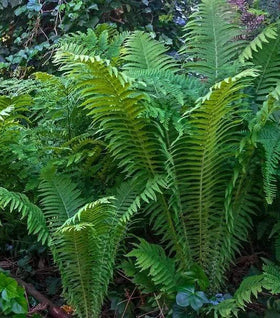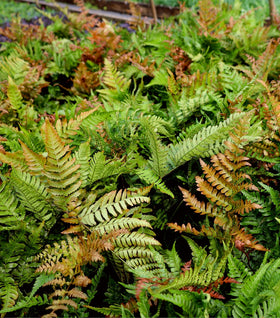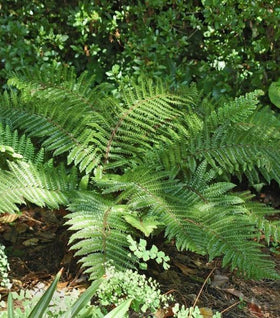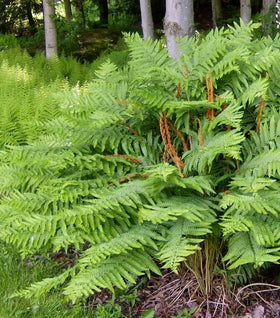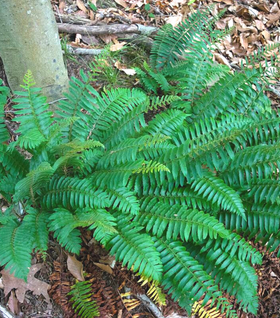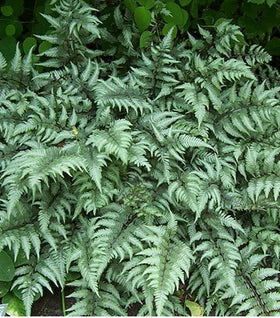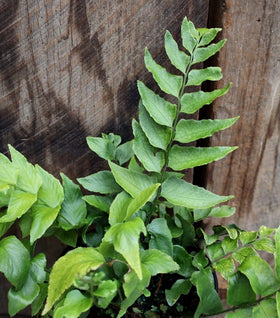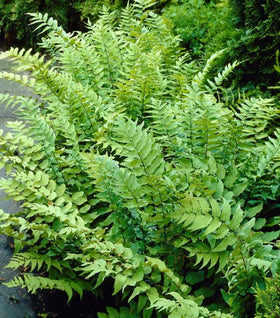Perennial Ferns for Sale Online
Perennial fern plants are an amazing way to bring lots of color and texture to all shaded areas of the landscape. They are easy to grow and will grow in areas where other plants cannot, including dry, shaded areas under mature trees. Certain ferns can also grow where the soil is moist and will naturalize where happy making them a good choice for use as a groundcover.
Some ferns have evergreen leaves, such as our native Christmas fern. Hardy Ferns look amazing when planted under large trees and can also be added to containers for shaded porches and patios.
Some woodland ferns feature colorful amber or brown scales covering the unfurling fronds, the fronds of other type turn attractive bronze shades at the end of the growing season.
How to Grow Ferns in the Garden
Most ferns grow best in loose, loamy, nutrient-rich soil that has a high organic matter content. Ferns naturally grow in wooded areas where leaves fall and become part of the soil profile. Before planting your ferns, prepare the soil by amending the existing soil with compost or peat moss. this will help your soil to retain moisture.
Though most ferns are not too particular about soil pH, some types do prefer acidic soil. If you're concerned about your soil pH, you can easily have your soil tested at your county extension office or with a simple at-home pH test kit. If you are planting your ferns in a woodland garden under oak trees or conifer trees, there is usually no need to be concerned with soil pH.
Do All Ferns Need shade?
While all ferns are shade-loving, some ferns will tolerate sun, provided the soil is loamy and doesn’t dry out. Ostrich ferns and cinnamon ferns are good choices for a relatively sunny location but not full sun.
Will Ferns Tolerate Dry Soil?
Most ferns prefer moist woodland type soils; there are a few types of ferns that will tolerate dry soils. For sites with dry soil, Christmas ferns or lady ferns are great choices. During periods of unusually hot, dry weather, your ferns may develop brown leaf edges or even wither. If this happens, cut the ferns back to the ground, and they will regrow once the temperatures cool down.
When is the Best Time to Plant Ferns?
The best time to plant ferns varies according to your location. Spring planting is preferred in areas where winters are cold and wet such as the northeast and upper midwest. If ferns are planted too late in the growing season in these areas, the roots may rot before the plants become established. The freezing and thawing may heave the plants from the soil, exposing the young roots to the sun and dry air, causing them to dry out.
In warmer areas of the country, fall planting is preferred because the young plants have time to establish a good root system before the summer heat and drought stresses arrive.
Our ferns are shipped year-round and are shipped in the pots they have been grown in for at least one full growing season. We do not ship bare-root plants, which often damages the roots and puts the plant at risk not to survive transplanting.
If you decide to move your ferns that are actively growing, be sure to cut the fronds back by half to reduce the stress from water loss and reduced root mass. This will help the fern to re-establish itself in its new home. New fronds will be produced as soon as the plant has enough new roots to support them.
What is the Best Way to Fertilize Ferns?
The delicate roots or Rhizomes of fern plants grow very close to the soil's surface and can be easily damaged or burned when fed with low-quality inorganic chemical fertilizers. These fertilizers tend to release all of their nutrients, causing an abnormal spike in the soil nutrients. Since ferns tend to grow in the nutrient-rich soils of woodlands, they are naturally able to draw nutrients throughout the growing season and prefer to do so naturally and at a constant rate.
It is widely recommended to feed ferns and other woodland plants with a slow-release natural fertilizer such as Holly-tone by Espoma. Holly-Tone is a natural way to feed plants, and the added acidity is a welcome addition to your fern garden. This can be done in the early spring and again in the very early summer before the summer heat sets in.
Companion Plants for Ferns
Ferns naturally grow well with other plants, so growing them in a mixed shade bed is recommended. Ferns grow well among spring-blooming plants such as woodland phloxes, hosta, heuchera, and liriope. Fens can be used to cover the dying foliage of bulbs such as crocus and even daffodils after they are done flowering in the spring.
Don't be afraid to try your own combinations, including flowering shrubs. While often called "Shady Characters," Ferns are not bullies, so they pair well with just about any shade-loving plant.

